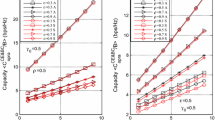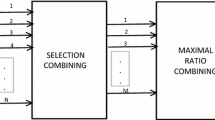Abstract
In contrary to Shannon’s ergodic capacity, the delay-constrained effective rate is used to define the maximum data rate of the real-time applications in 5G and beyond networks. Moreover, the received signal envelope in urban micro-cells environment follows a cascaded Rayleigh distribution with correlated channels. The effective capacity (EC) performance of the delay-sensitive communication system over the cascaded Rayleigh fading channel with arbitrary correlation is studied. The closed-form mathematical expressions for the EC are derived in terms of the Meijer's G-function and the effect of different fading parameters on the effective throughput of the system is demonstrated. The simplified asymptotic expression for high signal-to-noise ratio (SNR) and low SNR regimes are provided to gain more insight into the system. The effect of different system parameters on the EC performance is also demonstrated. Simulation results are corroborated along with the numerical results to verify the correctness of the formulation. To the best of the authors' knowledge, the derived expressions for this channel model are new and have not been reported in the literature.






Similar content being viewed by others
Data Availability
Not applicable.
Code Availability
Not applicable.
References
Kaur, M., & Yadav, R. (2022). EC analysis of multi-antenna system over 5G and beyond networks and its application to IRS-assisted wireless systems. Wireless Personal Communications, 124, 1861–1881.
Kaur, M., & Yadav, R. K. (2021). Effective capacity analysis over Fisher–Snedecor F fading channels with MRC reception. Wireless Personal Communications, 121, 1693–1705.
Wu, D., & Negi, R. (2003). Effective capacity: A wireless link model for support of quality of service. IEEE Transaction on Wireless Communications, 2(4), 630–643.
Lien, S. Y., Tseng, C. C., Chen, K. C., & Su, C. W. (2010). Cognitive radio resource management for QoS guarantees in autonomous femtocell networks. In IEEE international conference on communications (ICC), 2010.
Glisic, S., Nikolic, Z., Milosevic, N., & Pirinn, P. (2005). Effective capacity of advanced wireless cellular. In IEEE 16th international symposium on personal indoor and mobile radio communications (Vol. 4, pp. 2771–2780).
Qingxin, S., & Xiangquna, C. (2015). Effective capacity of cognitive radio systems in asymmetric fading channels. The Journal of China Universities of Posts and Telecommunications, 22(3), 18–25.
Piran, J., Pham, Q. V., Islam, S. R., Cho, S., Bae, B., Suh, D. Y., & Han, Z. (2020). Multimedia communication over cognitive radio networks from QoS/QoE perspective: A comprehensive survey. Journal of Network and Computer Applications. https://doi.org/10.1016/j.jnca.2020.102759
Du, X., & Zhang, Q. (2007). Cross-layer modeling for QoS-driven multimedia multicast/broadcast over fading channels in advances in mobile multimedia. IEEE Communications Magazine, 45(8), 62–75.
Wang, Q., Fan, P., Wu, D. O., & Letaief, K. B. (2011). End-to-end delay constrained routing and scheduling for wireless sensor networks. In IEEE international conference on communications (ICC), 2011.
Chen, Y., & Darwazeh, I.: End-to-end delay performance analysis in IEEE 802.16j mobile multi-hop relay (mmr) networks. In International conference on telecommunications (pp. 488–492).
Du, Q., Huang, Y., Ren, P., & Zhang, C. (2011). Statistical delay control and QoS-driven power allocation over two-hop wireless relay links. In IEEE global telecommunications conference—GLOBECOM, Houston, TX, USA, 2011.
Chen, Y., & Darwazeh, I. (2013). An estimator for delay distributions in distributions in packet-based wireless digital communication systems. In An estimator for d IEEE wireless communications and networking conference (WCNC), Shanghai, 2013.
Wang, X., & Zhang, J. (2017). Heterogeneous QoS-driven resource allocation over MIMO-OFDMA based 5G cognitive radio networks. In IEEE wireless communications and networking conference (WCNC), San Francisco, CA, 2017.
Zhang, J., & Wang, X. (2017). Statistical QoS-driven cooperative power. In Wireless communications and networking conference (WCNC), 2017 (pp. 1–6).
Chen, Y., Darwazeh, I., Philip, N., & Istepanian, R. (2013). End-to-end delay distributions in wireless tele-ultrasongraphy medical systems. In IEEE global communications conference, GA, USA, 2013.
You, M., Mou, X., & Sun, H. (2015). Effective capacity analysis of smart grid communication networks. In International workshop on computer aided modelling and design of communication links and networks, Guildford, UK, 2015.
Talha, B., & Patzold, M. (2011). Channel models for Mobile-to-Mobile cooperative communication systems: A state of the art review. IEEE Vehicular Technology Magazine, 6(2), 33–43.
Boulogeorgos, A. A., Sofotasios, P. C., Selim, B., Muhaidat, S., Karagiannidis, G. K., & Valkama, M. (2016). Effects of RF impairments in communications over cascaded fading channels. IEEE Transactions on Communications, 65(11), 8878–8894.
Bhowal, A., & Kshetrimayum, R. S. (2017). End to end performance analysis of M2M cooperative communication over cascaded a-µ channels. In 9th international conference on communication systems and networks (COMSNETS), Bangalore, India, 2017.
Ata, S. O. (2019). Secrecy performance analysis over cascaded fading channels. IET Communications, 13(2), 259–264.
Kong, L., Kaddoum, G., & da Costa, D. B. (2018). Cascaded a − µ fading channels: reliability and security analysis. IEEE Access, 6, 41978–41992.
Bekkali, A., Zou, S., Kadri, A., Crisp, M., & Penty, R. V. (2015). Performance analysis of passive UHF RFID systems under cascaded fading channels and interference effects. IEEE Transactions on Wireless Communications, 14(3), 1421–1433.
Alghorani, Y., Kaddoum, G., Muhaidat, S., & Pierre, S. (2015). On the approximate analysis of energy detection over n*Rayleigh fading channels through cooperative spectrum sensing. IEEE Wireless Communications Letters, 4(4), 413–416.
Sofotasios, P. C., Mohjazi, L., Muhaidat, S., Al-Qutayri, M., & Karagiannidis, G. K. (2016). Energy detection of unknown signals over cascaded fading channels. IEEE Antennas and Wireless Propagation Letters, 15, 135–138.
Alghorani, Y., Kaddoum, G., Muhaidat, S., Pierre, S., & Al-Dhahir, N. (2016). On the performance of multihop-intervehicular communications systems over n*Rayleigh fading channels. IEEE Wireless Communications Letters, 5(2), 116–119.
Ata, S. O. (2018). Secrecy performance analysis over double Nakagami-m fading channels. In 41st international conference on telecommunications and signal processing (TSP), Athens, Greece, 2018.
Peppas, K., Lazarakis, F., Alexandridis, A., & Dangakis, K. (2010). Cascaded generalised-K fading channel. IET Communications, 4(1), 116–124.
Yilmaz, F., & Alouini, M. (2009). Product of the powers of generalized Nakagami-m variates and performance of cascaded fading channels. In GLOBECOM 2009: 2009 IEEE global telecommunications conference, Honolulu, HI, USA, 2009.
Almers, P., Tufvesson, F., & Molisch, A. F. (2006). Keyhole effect in MIMO wireless channels: Measurements and theory. IEEE Transactions on Wireless Communications, 5(12), 3596–3604.
He, C., & Wang, Z. J. (2011). Closed-form BER analysis of non coherent FSK in MISO double Rayleigh fading/RFID channel. IEEE Communications Letters, 15(8), 848–850.
Griffin, J. D., & Durgin, G. D. (2007). Link envelop correlation in the backscatter channel. IEEE Communication Letters, 11(9), 735–737.
Chau, Y. A., & Huang, K. Y. (2012). On the second-order statics of correlated cascaded Rayleigh fading channels. International Journal on Antenna & Propagation. https://doi.org/10.1155/2012/108534
Erceg, V., Fortune, S. J., Ling, J., Rustako, A. J., & Valenzuela, R. A. (1997). Comparisons of a computer-based propagation prediction tool with experimental data collected in urban microcellular environments. IEEE Journal on Selected Areas in Communications, 15(4), 677–684.
Yadav, P., Kumar, S., & Kumar, R. (2020). Effective capacity analysis over α–κ–μ/Gamma composite fading channel. In IEEE international conference on advances in computing, communication control and networking (ICACCCN), Greater Noida, India, 2020.
Ghareeb, A., & Darwish, J. (2020). Statastics of cascaded Rayleigh fading channels with arbitrary correlation. IET Communications, 14(16), 2849–2857.
Adamchik, V., & Marichev, O. (1990). The algorithm for calculating integrals of hypergeometric type functions and its realization in REDUCE system. In International conference on symbolic and algebraic computation, New York (USA), 1990.
Prudnikov, A. P., & Brychkov, Y. A. (1986). Integrals and series volume 3, more special functions (1st ed.). Gordon and Breach Science Publishers.
Gradshteyn, I., & Ryzhik, I. (2007). Table of integrals, series and products (7th ed.). Academic Press.
Matthaiou, M., & Zhong, C. (2012). Low-SNR analysis of MIMO Weibull fading channel. IEEE Communications Letters, 16(5), 694–697.
Yadav, P., Kumar, S., & Kumar, R. (2021). Analysis of EC over Gamma shadowed α–η–μ fading channel. In IOP conference series: material science & engineering, 2021.
Funding
No funding was received for this work.
Author information
Authors and Affiliations
Contributions
All the authors have equally contributed in this manuscript.
Corresponding author
Ethics declarations
Conflict of interest
The authors declare that there is no conflict of interest.
Additional information
Publisher's Note
Springer Nature remains neutral with regard to jurisdictional claims in published maps and institutional affiliations.
Rights and permissions
Springer Nature or its licensor (e.g. a society or other partner) holds exclusive rights to this article under a publishing agreement with the author(s) or other rightsholder(s); author self-archiving of the accepted manuscript version of this article is solely governed by the terms of such publishing agreement and applicable law.
About this article
Cite this article
Kumar, S., Chauhan, P.S., Kaur, M. et al. Effective Capacity Analysis over Cascaded Rayleigh Fading Channels with Arbitrary Correlation. Wireless Pers Commun 129, 173–189 (2023). https://doi.org/10.1007/s11277-022-10091-8
Accepted:
Published:
Issue Date:
DOI: https://doi.org/10.1007/s11277-022-10091-8




